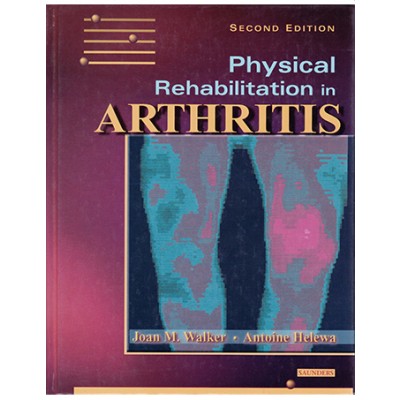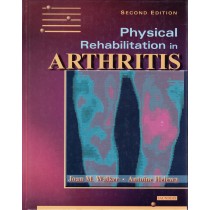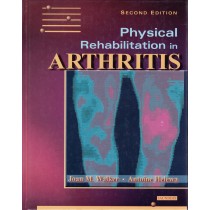
Physical Rehabilitation in Arthritis: Module 1
SKU: 716
by Joan M. Walker, PhD, MA, Dip TP, BOT, Certifs in PT (NZ)
and Antoine Helewa, MSc (Clin Epid), PT
This course is offered in cooperation with Elsevier Science and utilizes the textbook “Physical Rehabilitation in Arthritis”c2004. This exciting book is devoted to the treatment of patients with arthritis and rheumatic diseases. Textbook discusses epidemiology, diagnostic information, pharmacology, surgical interventions, and management and rehabilitation issues. This course is essential to all therapists dealing with geriatrics!
Module 1 covers history of arthritis, epidemiology, pathophysiology, diagnosis and medical management of conditions with arthritis and assessment of joint disease
Module 2 covers pharmacology, surgical interventions, juvenile rheumatoid arthritis, rheumatoid arthritis and ankylosing spondylitis
Module 3 covers osteoarthritis, chronic muscle pain syndromes, patients with multiple joint involvement, splinting, orthotics, psychosocial factors, community-based physical rehabilitation and special topics in clinical research.
Entire textbook length is 414 pages.
Course Length: 7.0 contact hours
Instructional Level: Beginner/Intermediate
This package contains the required reading and test materials for Module 1 only.
Physical Rehabilitation in Arthritis: Module 1
Course Goals and Objectives:
Course Goals:
This course is intended to instruct the student through self-paced study of the physical rehabilitation and treatment of patients with arthritic diseases.
Student Objectives
At the end of this course the student will be able to:
1. Identify the role of physical and occupational therapy in the management of arthritis from past to present.
2. Identify the effect of cultural attitudes and beliefs with the treatment of arthritis.
3. Identify the criteria for the classification of rheumatoid arthritis.
4. Identify the criteria for the classification of juvenile rheumatoid arthritis.
5. Identify the criteria for diagnosing ankylosing spondylitis.
6. Identify the socioeconomic impact of arthritis.
7. Identify 9 different types of collagen in healthy human articular tissues.
8. Identify the pathological changes that occur with rheumatoid arthritis, psoriatic arthritis, ankylosing spondylitis, infectious arthritis, hemophilic arthritis, crystal-associated (gouty) arthritis and neuropathic arthritis.
9. Identify the effects of inactivity on ligaments, tendons, articular cartilage and bone.
10. Define arthritis.
11. Identify clinical features, treatment and prognosis of rheumatoid arthritis.
12. Identify 3 classes of drugs used to manage rheumatoid arthritis.
13. Identify 4 examples of disease-modifying antirheumatic drugs and their potential side-effects.
14. Identify the clinical features of ankylosing spondylitis.
15. Identify the clinical features of Reiter’s Syndrome.
16. Identify the clinical features of enteropathic arthritis, psoriatic arthritis and osteoarthritis.
17. Identify the most common form of arthritis.
18. Identify the clinical features of gout.
19. Identify 3 major subsets of juvenile rheumatoid arthritis and the clinical signs of each of them.
20. Identify the clinical features of systemic lupus erythematosus.
21. Identify 4 connective tissue disorders.
22. Identify the clinical features of fibromyalgia.
23. Identify the 4 measures of value identified by the American Rheumatism Association in measuring the activity of rheumatoid arthritis.
24. Identify the advantages of using a modified blood pressure cuff to measure grip and muscle strength.
25. Identify the key areas to be addressed during patient evaluation with an arthritic patient.
26. Identify the criteria for diagnosis of fibromyalgia.
27. Identify techniques of spinal examination.
SKU: 716
by Joan M. Walker, PhD, MA, Dip TP, BOT, Certifs in PT (NZ)
and Antoine Helewa, MSc (Clin Epid), PT
This course is offered in cooperation with Elsevier Science and utilizes the textbook “Physical Rehabilitation in Arthritis”c2004. This exciting book is devoted to the treatment of patients with arthritis and rheumatic diseases. Textbook discusses epidemiology, diagnostic information, pharmacology, surgical interventions, and management and rehabilitation issues. This course is essential to all therapists dealing with geriatrics!
Module 1 covers history of arthritis, epidemiology, pathophysiology, diagnosis and medical management of conditions with arthritis and assessment of joint disease
Module 2 covers pharmacology, surgical interventions, juvenile rheumatoid arthritis, rheumatoid arthritis and ankylosing spondylitis
Module 3 covers osteoarthritis, chronic muscle pain syndromes, patients with multiple joint involvement, splinting, orthotics, psychosocial factors, community-based physical rehabilitation and special topics in clinical research.
Entire textbook length is 414 pages.
Course Length: 7.0 contact hours
Instructional Level: Beginner/Intermediate
This package contains the required reading and test materials for Module 1 only.
Physical Rehabilitation in Arthritis: Module 1
Course Goals and Objectives:
Course Goals:
This course is intended to instruct the student through self-paced study of the physical rehabilitation and treatment of patients with arthritic diseases.
Student Objectives
At the end of this course the student will be able to:
1. Identify the role of physical and occupational therapy in the management of arthritis from past to present.
2. Identify the effect of cultural attitudes and beliefs with the treatment of arthritis.
3. Identify the criteria for the classification of rheumatoid arthritis.
4. Identify the criteria for the classification of juvenile rheumatoid arthritis.
5. Identify the criteria for diagnosing ankylosing spondylitis.
6. Identify the socioeconomic impact of arthritis.
7. Identify 9 different types of collagen in healthy human articular tissues.
8. Identify the pathological changes that occur with rheumatoid arthritis, psoriatic arthritis, ankylosing spondylitis, infectious arthritis, hemophilic arthritis, crystal-associated (gouty) arthritis and neuropathic arthritis.
9. Identify the effects of inactivity on ligaments, tendons, articular cartilage and bone.
10. Define arthritis.
11. Identify clinical features, treatment and prognosis of rheumatoid arthritis.
12. Identify 3 classes of drugs used to manage rheumatoid arthritis.
13. Identify 4 examples of disease-modifying antirheumatic drugs and their potential side-effects.
14. Identify the clinical features of ankylosing spondylitis.
15. Identify the clinical features of Reiter’s Syndrome.
16. Identify the clinical features of enteropathic arthritis, psoriatic arthritis and osteoarthritis.
17. Identify the most common form of arthritis.
18. Identify the clinical features of gout.
19. Identify 3 major subsets of juvenile rheumatoid arthritis and the clinical signs of each of them.
20. Identify the clinical features of systemic lupus erythematosus.
21. Identify 4 connective tissue disorders.
22. Identify the clinical features of fibromyalgia.
23. Identify the 4 measures of value identified by the American Rheumatism Association in measuring the activity of rheumatoid arthritis.
24. Identify the advantages of using a modified blood pressure cuff to measure grip and muscle strength.
25. Identify the key areas to be addressed during patient evaluation with an arthritic patient.
26. Identify the criteria for diagnosis of fibromyalgia.
27. Identify techniques of spinal examination.





